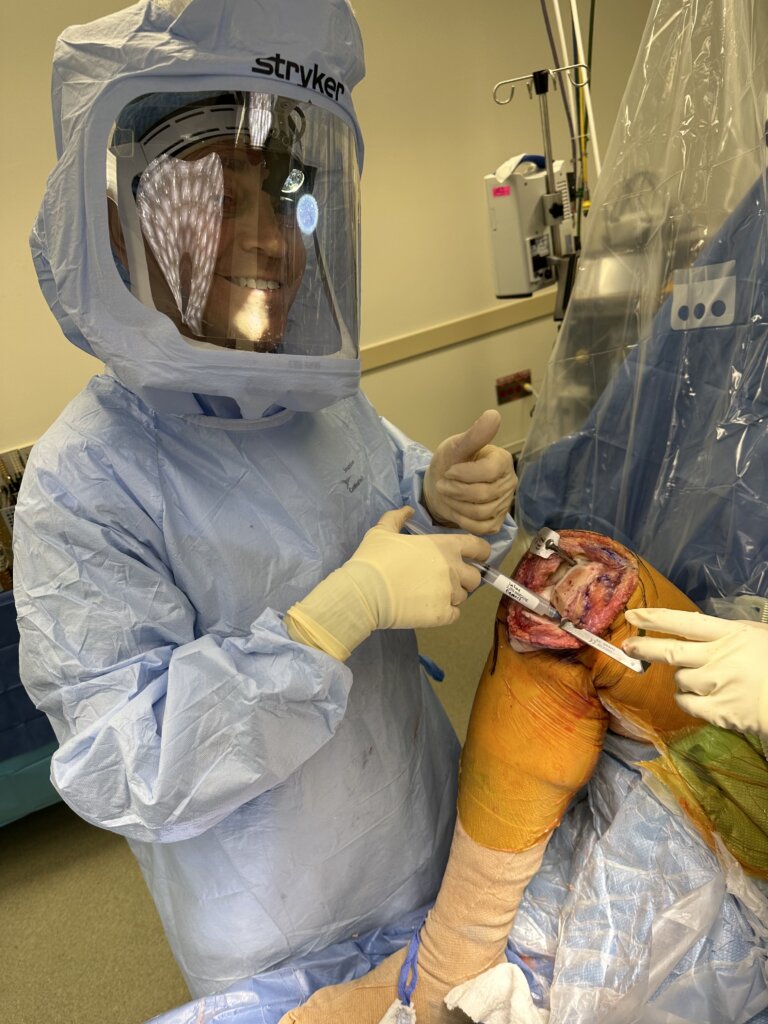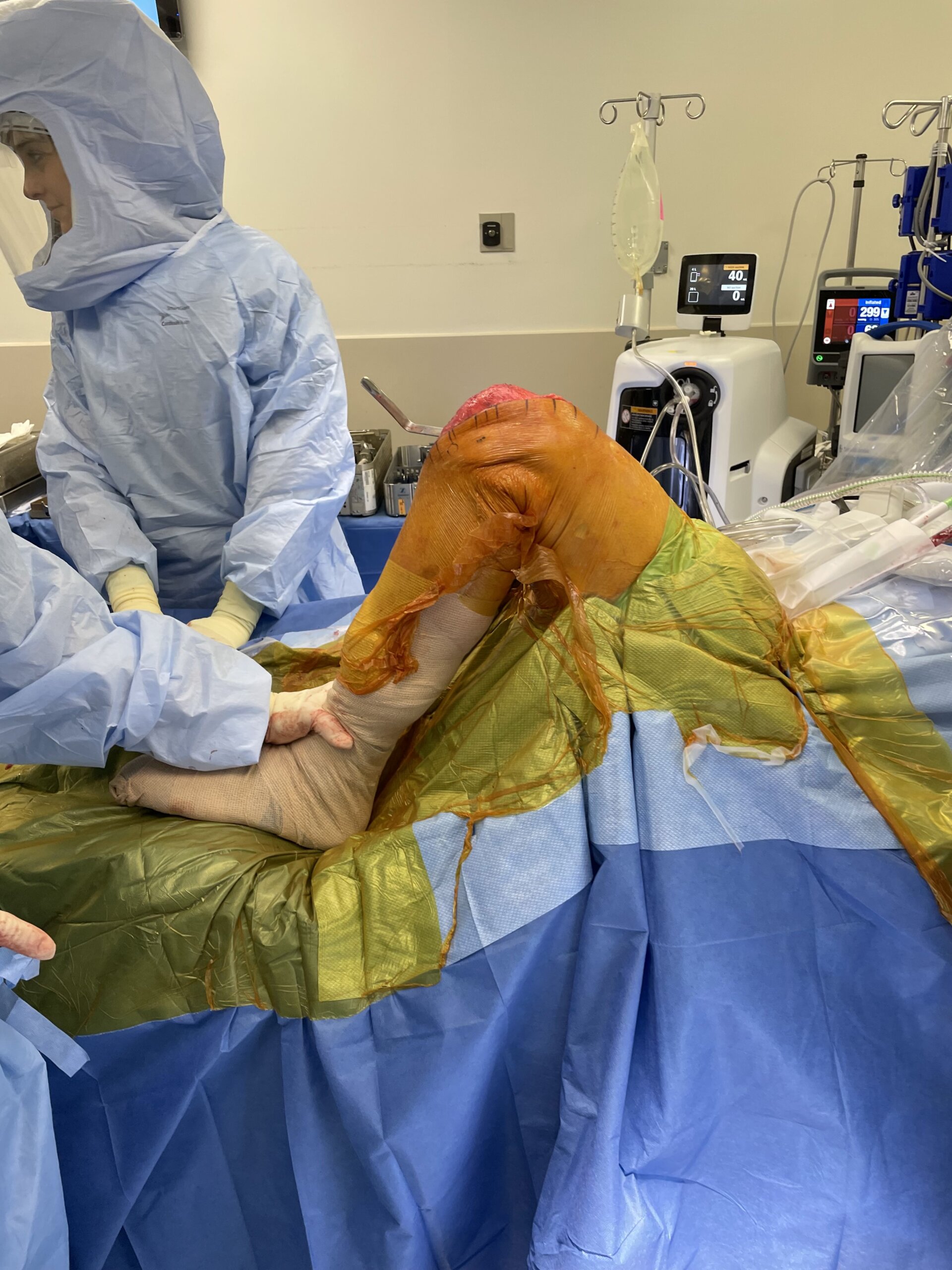Understanding the costs of knee arthroplasty surgery is crucial before you proceed. Plancher Orthopaedics covers everything from the types of knee surgeries to factors affecting the total cost and what your insurance might cover.
Key Takeaways
- Total Knee Arthroplasty (TKA) and Partial Knee Arthroplasty (PKA) offer solutions to severe knee pain, with TKA being more comprehensive and expensive, and PKA being less invasive and costly.
- Various factors influence the cost of knee arthroplasty, including surgery type, geographic location, hospital choice, knee implants, surgeon fees, and surgical techniques, with total costs in the U.S. ranging from $15,000 to $75,000.
- Insurance, including Medicare and private plans, significantly aids in covering knee arthroplasty costs but understanding individual plan details regarding deductibles, copays, and covered services is crucial for financial planning.

Types of Knee Arthroplasty Surgeries
When persistent knee pain begins to impact your daily life, knee replacements, such as knee arthroplasty, may provide a solution. Two paths lie ahead: Total Knee Arthroplasty (TKA) and Partial Knee Arthroplasty (PKA). With TKA, also known as total condylar knee arthroplasty, surgeons replace the entire knee joint with artificial surfaces designed to replicate natural knee function. Given its comprehensive approach to treating knee pain, this surgical procedure is more common, albeit with a higher price tag, with costs in the United States averaging between $30,000 and $50,000.
On the other hand, PKA, or unicompartmental knee arthroplasty, is a less invasive option where only the damaged compartment of the knee receives a new lease on life through partial knee replacement surgery. This procedure is not only less common but also less burdensome on your wallet, with average costs ranging from $20,000 to $35,000. Both procedures ultimately strive for the same goal: to relieve your knee pain and restore your mobility, yet they differ significantly in their financial implications.
Factors Influencing the Cost of Knee Arthroplasty
The cost of knee arthroplasty can vary based on various factors, including:
- The type of surgery chosen
- The geographic location
- The hospital or surgery center where the knee replacement surgery takes place
- The knee implant itself, with prices generally ranging from $3,000 to $10,000
- Surgeon’s fees
- The use of cutting-edge surgical techniques
These factors can all contribute to the overall cost of knee arthroplasty.
Beyond the operating room, the entire healthcare journey, from preoperative care to the potential potholes of postoperative complications, influences knee replacement costs. It’s a tapestry woven with intricate details, each thread a cost that contributes to the total sum, which can range anywhere from $15,000 to $75,000 in the United States. Comprehending each component becomes critical when preparing for the financial implications of your knee surgery.
Breakdown of Preoperative Costs
Before embarking on the journey to the operating room, there are preoperative costs to consider. These preliminary expenses include an initial consultation fee, typically around $200, which may be a drop in the ocean compared to the total surgery cost but is essential for setting the stage for a successful surgical outcome. Diagnostic studies such as labs, MRIs, and X-rays play a pivotal role in mapping out the surgical plan and minimizing risks, further contributing to the out-of-pocket costs.
Specialist consultations are another stepping stone along the pre-surgery path, essential for assessing medical risk and determining the best course of action for your unique health profile. While these costs may seem like mere preludes to the symphony of surgery, they are integral to ensuring the highest standards of care and the best possible outcome for your knee replacement procedure.
Surgical Procedure Costs
The climax in the cost of knee arthroplasty comes on the day of the surgery itself. The operating room fees account for a significant portion of the bill, encompassing the surgeon’s expertise, the operative staff’s skills, and the time spent within the theater of surgery. Anesthesia costs echo through the room as well, as the anesthesia team weaves its magic to ensure you experience no pain during the procedure.
Surgeon fees also make a notable guest appearance in the financial breakdown of your knee surgery, although they typically represent less than 10% of the total surgery cost, with Medicare reimbursement for a knee replacement hovering around $1,450. Innovations in surgical technique, such as new technologies, can elevate the cost, but they also hold the promise of improved outcomes and potentially greater cost-effectiveness in the long run.
Postoperative Care and Recovery Expenses
Once the surgical procedure concludes, the recovery phase commences, ushering in its own set of expenses. The immediate postoperative care may involve a hospital stay, or for some, a unique recovery option such as a hotel stay with round-the-clock nursing and rehab staff, a modern twist on the traditional hospital setting. Physical therapy then takes the stage, a crucial player in regaining strength and mobility, which can entail an average of 33.2 outpatient visits in the year following total knee replacement surgery, significantly adding to the overall knee replacement cost.
The spotlight also shines on postoperative prescriptions, including pain relievers and blood thinners, which can be an additional burden if not fully covered by insurance. If the plot thickens with complications, unexpected costs for additional care or medical equipment can add layers of complexity to the financial aspect of recovery, emphasizing the importance of health insurance coverage and thorough planning.
Insurance Coverage for Knee Arthroplasty
Insurance coverage serves as your defense against the financial implications of knee arthroplasty. Amidst the symphony of medical bills, insurance serves as a conductor, orchestrating what costs will be covered and to what extent. Most health insurance plans, including HealthPartners, Medicare, and Medicaid, play a key role in covering a significant portion of knee replacement surgery, from preoperative evaluations to postoperative care.
However, the harmony of coverage can vary, leaving you to pay out of pocket for certain aspects depending on copays, deductibles, or coinsurance.
Medicare
For those enrolled in Medicare, the program typically covers both inpatient and outpatient surgery costs to a significant extent. Medicare Part A provides a safety net for inpatient hospital costs related to knee replacement surgery after a deductible is met and can extend to cover a brief stay in a skilled nursing facility if needed. Medicare Part B, on the other hand, usually covers 80% of the services by doctors during hospitalization, including surgery and any related medications.
Medicare beneficiaries should also be aware of the durable medical equipment that may be necessary during recovery. Items such as walkers, ice machines, or crutches are typically covered under Medicare Part B, although coverage can vary with private insurance plans. Exploring Medicare Advantage plans or Medicare Part D Prescription Drug Plans may provide additional avenues to reduce out-of-pocket expenses.
Private Insurance
Navigating the intricacies of private insurance coverage necessitates meticulous attention to detail. Each plan is a bespoke contract, with fees pre-negotiated between the insurance provider and hospitals or providers, leading to significant variability in coverage. It’s essential to review your benefits plan carefully, understanding the lay of the land in terms of deductibles, in-network providers, and covered services before scheduling your knee surgery.
With private insurance, the quest to decipher what portion of the knee replacement cost you’ll need to pay out of pocket is a critical one. The average coinsurance rate for hospital admission, for example, maybe around 20%, influencing the total out-of-pocket cost you’ll incur. Knowing the fine print of your insurance plan is key to preparing for the financial aspects of your recovery journey.
Additional Costs to Consider
Apart from the direct costs of knee replacement surgery, additional out-of-pocket expenses may also arise. Home medical equipment such as crutches, walkers, or safety bars are not just accessories but necessities for a safe recovery journey. Home modifications, too, like installing a toilet seat riser or adding handrails, though seemingly minor, can add up to a substantial outlay.
Then there’s the matter of lost income. The time taken off work for surgery and recovery isn’t just a hiatus from your routine; it’s an economic factor that can weigh heavily on your wallet, especially if disability insurance isn’t part of your financial equation. These additional expenses are the often-unheralded players in the orchestra of costs related to knee arthroplasty, and they warrant careful consideration and planning.
Strategies to Reduce Out-of-Pocket Costs
Nevertheless, there are ways to manage your medical bills effectively. There are strategies to reduce the financial strain, such as discussing payment plans with hospitals to distribute the cost of knee replacement surgery over time. Adventurous souls might even consider overseas surgery options, where the cost of knee replacement surgeries and hip replacement surgeries can be significantly lower, though this comes with its own set of considerations.
Outpatient surgery centers are another avenue worth exploring, as they typically offer lower costs compared to traditional hospitals. Additionally, innovative solutions like hotel recovery programs can offer a financially savvy alternative to prolonged hospital stays, without compromising the quality of postoperative care. These strategies are not just about saving money; they’re about smartly navigating the healthcare landscape to optimize your recovery both physically and financially.
Personalized Consultation with Dr. Kevin D. Plancher
Despite the complexity of knee arthroplasty, personalized medical care can be a game-changer. Dr. Kevin D. Plancher, with his extensive expertise in orthopaedic medicine, offers a haven for those seeking knee and shoulder arthroplasty, with an emphasis on joint preservation and patient-centric care. From the moment you step into his practice, the experience is tailored to your comfort, with direct access to Dr. Plancher and his team, ensuring that your concerns and needs are addressed with the utmost attention.
Dr. Plancher’s practice offers:
- A comprehensive resource center with a patient education series
- Insightful videos by Dr. Plancher
- A health insights blog that keeps you at the forefront of orthopaedic knowledge
It’s a holistic approach to healthcare that places patient satisfaction and well-being at the core of every interaction.
Summary
As we bring the curtain down on our exploration of knee arthroplasty costs, remember that knowledge is the key to unlocking a financially manageable path to recovery. From understanding the different surgical options and their costs to navigating the intricate world of insurance coverage and considering additional out-of-pocket expenses, every step you take towards educating yourself is a step away from the uncertainty that often shadows medical procedures. May this guide serve as a beacon, illuminating your journey to a pain-free stride and a financially secure future.
Frequently Asked Questions
What is the difference between Total Knee Arthroplasty (TKA) and Partial Knee Arthroplasty (PKA)?
The main difference between Total Knee Arthroplasty (TKA) and Partial Knee Arthroplasty (PKA) is that TKA replaces the entire knee joint with artificial components, while PKA only replaces one damaged compartment of the knee. TKA is more common and usually more expensive than PKA.
How much does the average knee replacement surgery cost?
The average cost of knee replacement surgery can range from $30,000 to $112,000 for total joint replacement and $20,000 to $35,000 for partial knee replacements. These costs can vary widely.
Are there additional costs associated with knee arthroplasty beyond the surgery itself?
Yes, there are additional costs associated with knee arthroplasty beyond the surgery itself, such as preoperative consultations, diagnostic studies, home medical equipment, home modifications, postoperative care like physical therapy, and potential lost income during recovery.
Will my health insurance cover the cost of knee arthroplasty?
Yes, most health insurance plans, including Medicare and Medicaid, cover knee arthroplasty surgery to varying extents, but the patient’s share of costs depends on the specific plan.
What strategies can I use to reduce out-of-pocket costs for knee replacement surgery?
Consider discussing payment plans, exploring surgery abroad or outpatient centers, and understanding health insurance coverage to reduce out-of-pocket costs for knee replacement surgery. It’s important to consider all options before making a decision.





 William D. Murrell, MD
William D. Murrell, MD Thomas B. Evely, DO
Thomas B. Evely, DO Clifford Voigt, MD
Clifford Voigt, MD Karthikeyan Chinnakkannu, MD
Karthikeyan Chinnakkannu, MD Max N. Seiter, MD
Max N. Seiter, MD Demetris Delos, MD
Demetris Delos, MD Lauren M. Fabian, MD
Lauren M. Fabian, MD